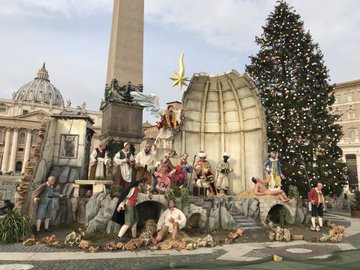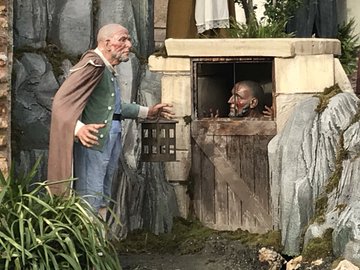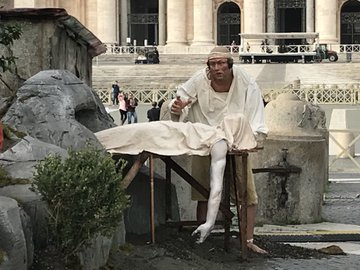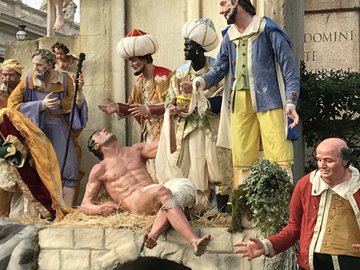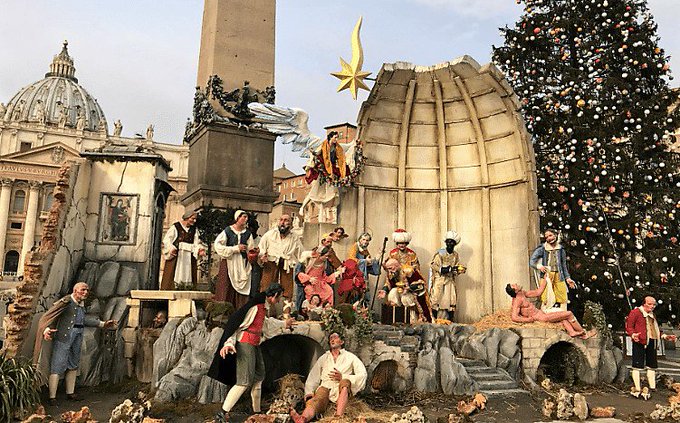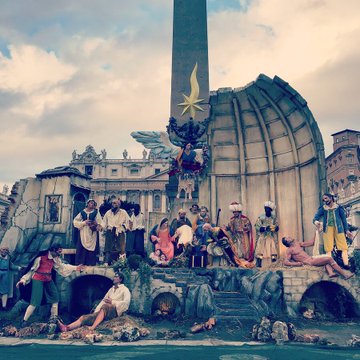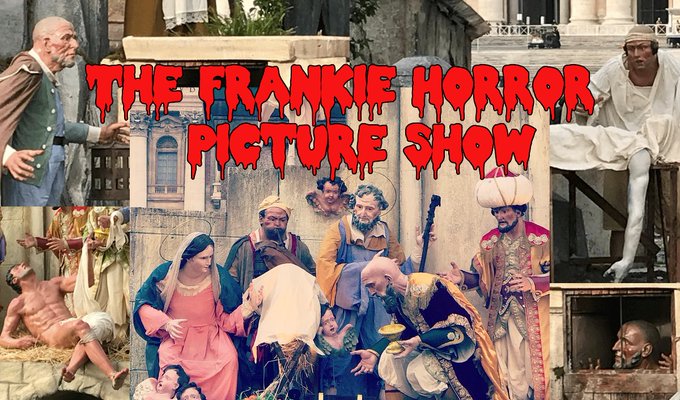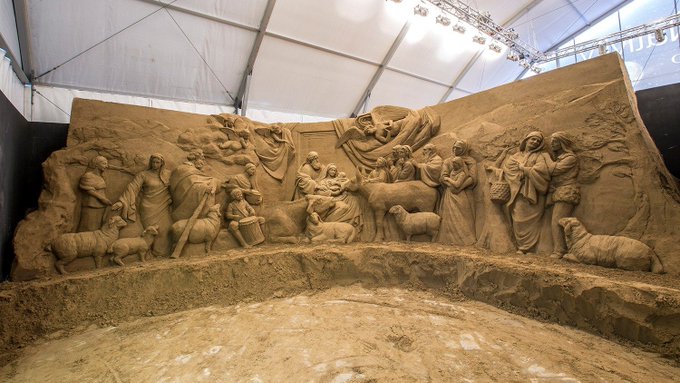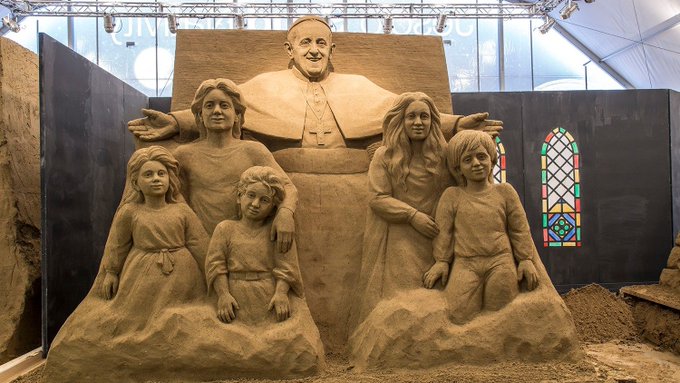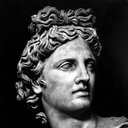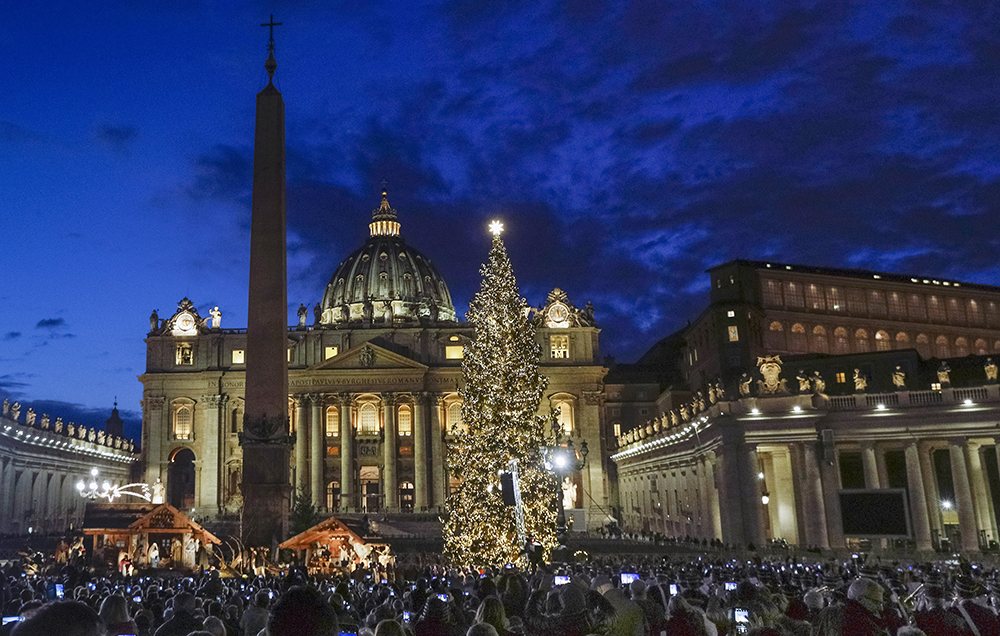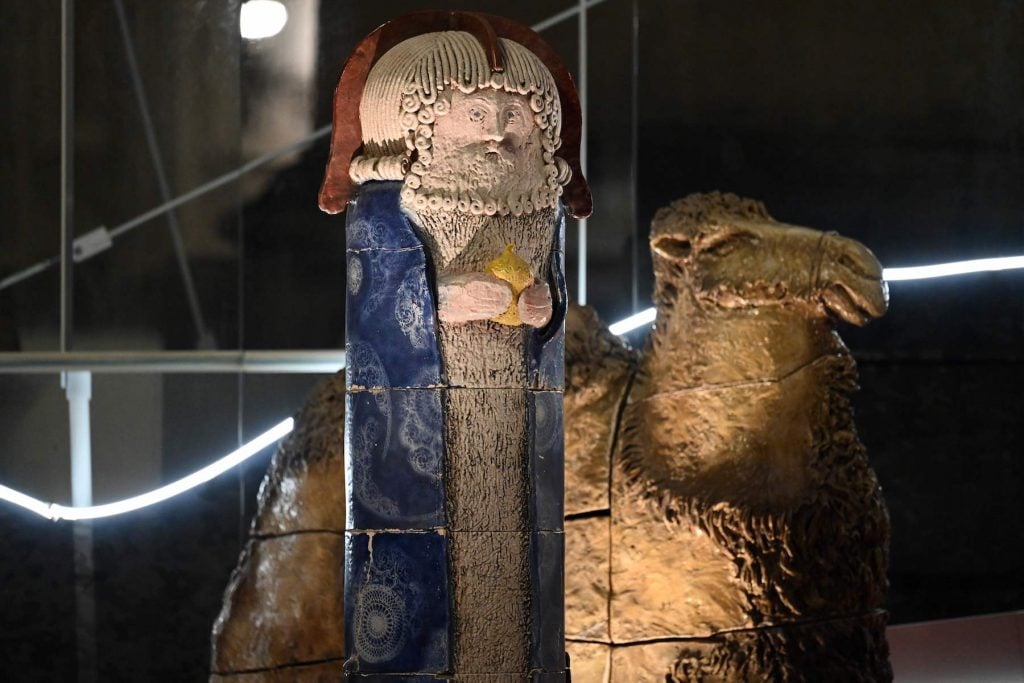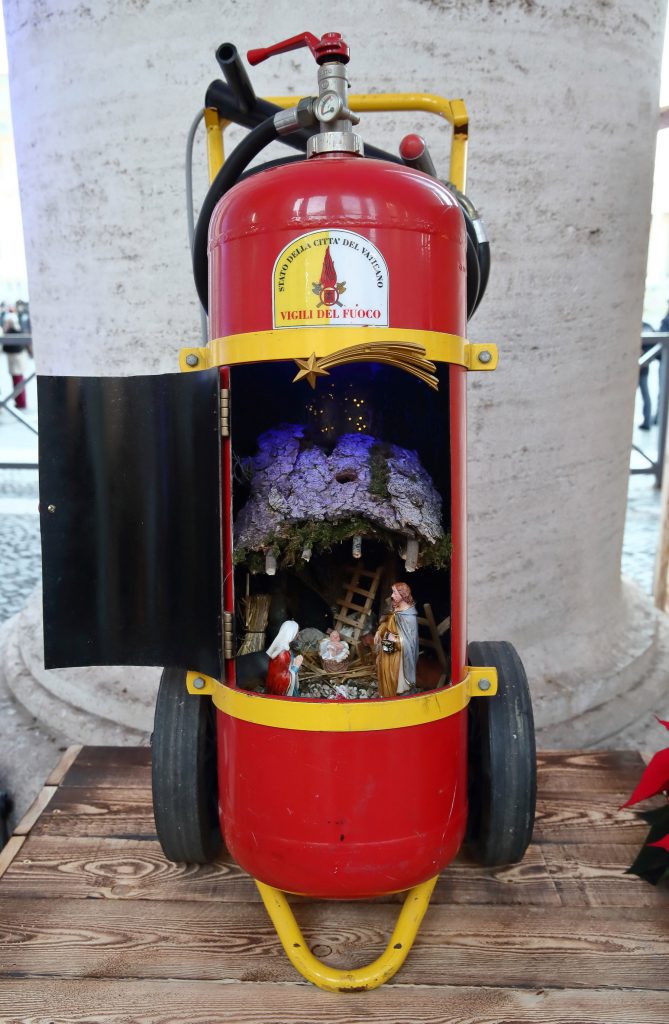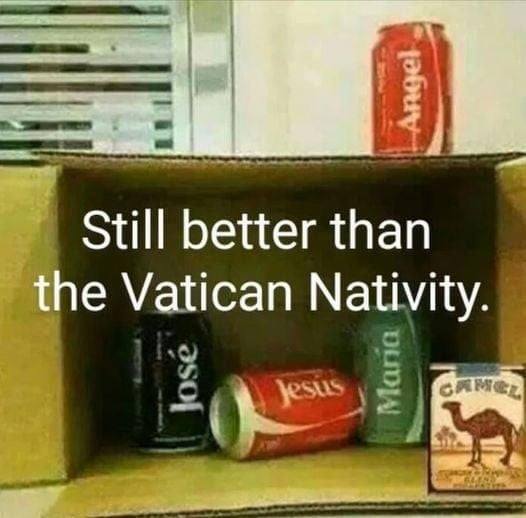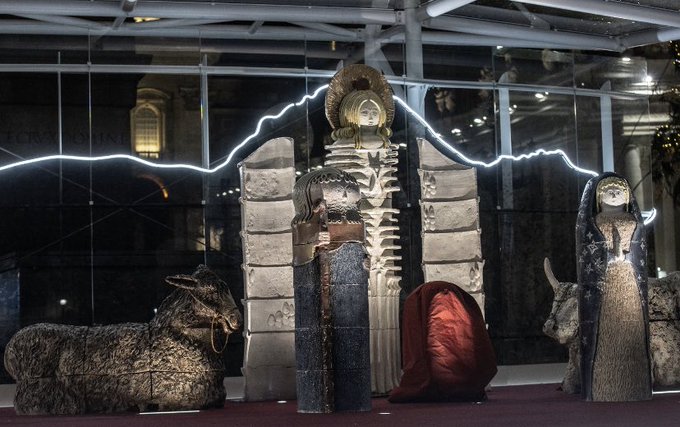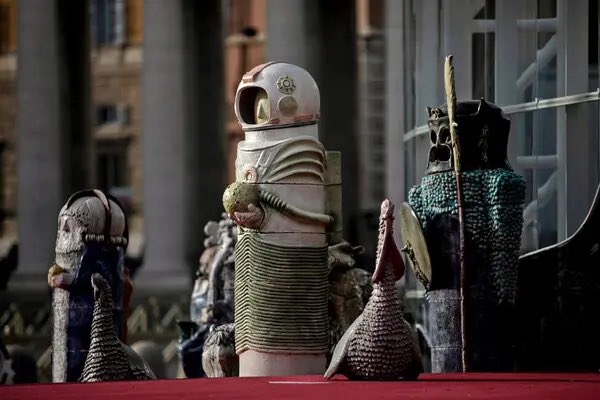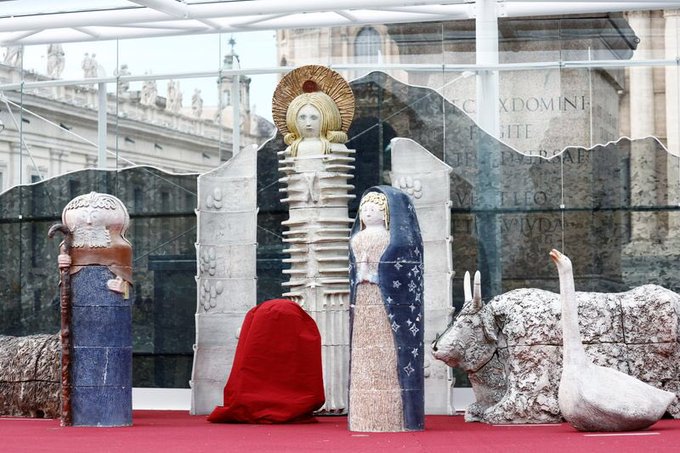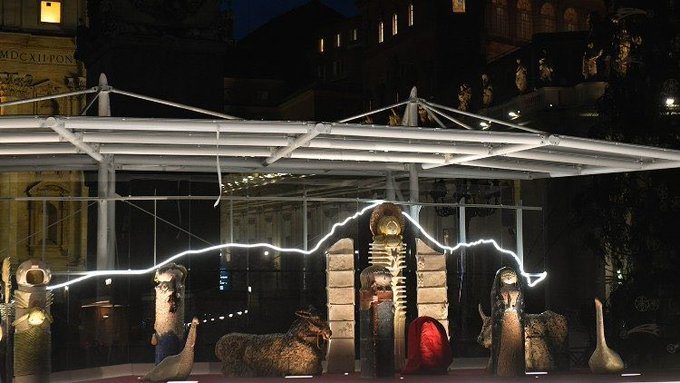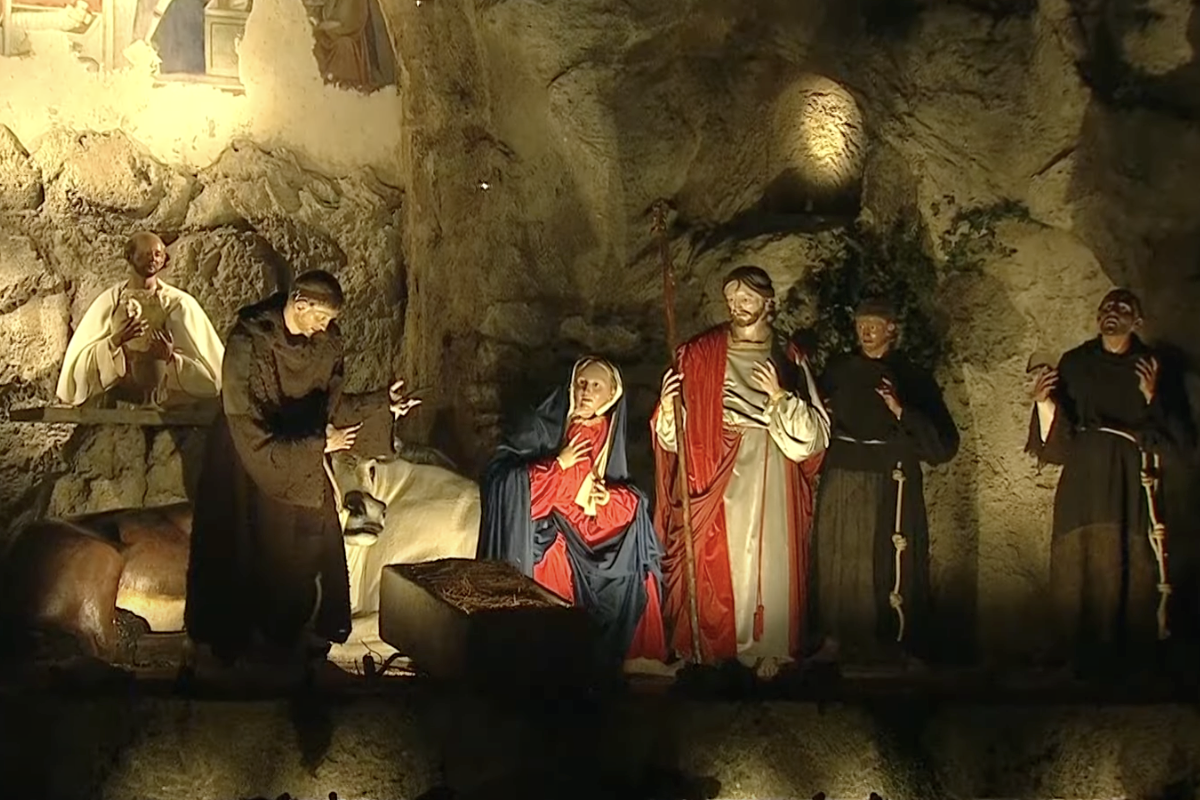
RESTORED and UPDATED 5/18/24
Take a little trip with me through the history of the Vatican Nativity Scenes. It is a wild ride. With a strange ending.
The Vatican Nativity in Saint Peter’s Square is relatively new. It was started by Pope John Paul II in 1982.
For 30 years, the same figures were used, but the Vatican paid for a new scene each Christmas.
It was actually Archbishop Viganò who approached Pope Benedict in 2011 with the costs for the yearly crèche.The total costs for building the scene went well into the hundreds of thousands each year. This was around the time of Vatileaks.
An idea was then suggested to have a nativity donated from different regions of Italy, and that began in 2012.
I’m sure they meant well, but it opened the door to new takes on the nativity. Most turned out nicely.
We talk about the Vatican crèche and more on the latest podcast.
Here are a few shots using the original figures that I took in previous years.
VATICAN NATIVITY 2011
2012 Donated by Basilicata
This was the first year to use new figures. They did a great job with the scene, but the figures were so tiny.
Vatican denies free Christmas nativity crib linked to corruption scandal
The Vatican said on Thursday there was no link between its decision to accept the gift of a nativity scene in St Peter’s Square and allegations that it had previously paid inflated prices to have them built.
VATICAN CITY—The Vatican said on Thursday there was no link between its decision to accept the gift of a nativity scene in St Peter’s Square and allegations that it had previously paid inflated prices to have them built.
This year’s larger-than-life Christmas tableau depicting the biblical scene of Jesus’s birth, worth about $120,000 U.S., was donated by the southern region of Basilicata, one of Italy’s poorest.
Some of the documents that sparked this year’s ‘Vatileaks’ scandal indicated that in 2009 the Vatican paid an Italian company six times that amount, about $720,000, to build its nativity scene in the square.
Monsignor Giuseppe Sciacca, deputy governor of the Vatican City, was asked by reporters whether accepting a donated crib was a response to the scandal.
“This is exclusively the result of the offer by the Basilicata region to give us this gift, which, with a minimum of good sense, has been accepted,” he said.
In the leaked documents, Sciacca’s predecessor, Archbishop Carlo Maria Vigano, said the exorbitant cost of the 2009 crib was an example of how the Vatican was losing money through corruption.
Vigano said he had managed almost to halve the cost of the 2010 crib. He was subsequently transferred to the United States, despite an appeal to his superiors to be allowed stay in his job, in what he saw as punishment for doing his work too well.
Two people were convicted by a Vatican court over the leaks of documents.
Paolo Gabriele, the Pope’s former butler, is now serving an 18-month jail sentence in a Vatican jail cell for stealing sensitive papal documents and leaking them to the media.
A computer expert was given a suspended sentence for obstructing justice in the case.
READ MORE: Here’s what Pope Benedict XVI wrote in his first tweet
2013 Donated by Naples
Pope Francis’ first nativity. A bit crowded.
Vatican unveils Nativity scene on pope’s first Christmas

VATICAN CITY: Pope Francis on Tuesday prepared to celebrate his first Christmas as pontiff with a mass in St Peter’s Basilica as a giant traditional Nativity scene named in his honour was unveiled on St Peter’s Square.
The Nativity scene made by Naples artisan Antonio Cantone this year is entitled “Francis 1223 — Francis 2013” –– a reference to St Francis of Assisi, who inspired the pope’s choice of name when he was elected.
The saint is commonly credited with being behind the first representation of the Nativity, staged with live actors as is still done in many parts of the world.
Cantone told AFP ahead of the ceremony that he had wanted to build a Nativity to reflect the pope’s humble style, giving more prominence to ordinary people dressed in simple clothes in the traditional scene of the birth of Jesus.
“I have based the scene on the message of Pope Francis,” Cantone said in an interview in his workshop in the bustling centre of Naples earlier this month. (BUT, isn’t Christmas supposed to be to honor Jesus Christ, and celebrate his birth? Why is the pontiff being lifted up, honored and made the center of the focus?)
“The first to arrive when Jesus was born were ordinary people, that is the core of the message I wanted.”
Elaborate Nativity scenes became popular in Naples churches in the 18th century to make religious teachings more widely understandable by including snapshots of daily life that people could relate to.
The custom was then adopted by the aristocracy and spread to ordinary people, becoming a yearly and much-loved tradition for millions of Italians.
The most traditional statuettes are painstakingly hand crafted out of terracotta, given glass eyes and painted — each one a unique work of folk art.
Vatican City, Jan 16, 2014 / 04:42 am
The man in charge of constructing this year’s nativity scene for the Vatican expressed his delight at giving to Pope Francis the nativity he designed, which, he noted, has a special historical significance.
“We had the honor of being in a private audience with the Pope” and with “Cardinal Sepe on Dec. 23” nativity designer Antonio Cantone told CNA in a Jan. 14 interview, where “we presented our donation; the nativity scene.
“The Pope,” recalled the designer, “was extremely happy to see a nativity scene so special, so beautiful in his square.”
Designed and carved primarily by Cantone and his wife, this year’s nativity was created to depict the traditional style of Naples, an Italian city that has been famous for its nativity scenes since the 17th century.
“The Neapolitan nativity is extremely important in art history because it has had a remarkable success in the whole world” Cantone noted, stating that “In fact, most people understand the Neapolitan nativity as the only nativity, and not that of any other nationality.”
Located at the center of St. Peter’s Square in Rome, this is the first time the Vatican’s nativity scene has been depicted the historic Neapolitan style, which, the designer observed, initially caused problems with the size of the statues.
“Neapolitan figures have a maximum height of 50 centimeters,” however the statues were made to be “two meters tall” so that they can be “visible from great distances,” he explained.
Cantone emphasized that it took him and his wife, along with others who helped in the project, “a year” to do “the figures only.”
When asked if there were any hidden details on the nativity scene, as is sometimes done in some styles, Cantone stated that “No,” there was not, and that “for those who know the Neapolitan nativity scene, no.”
However, the designer drew attention to the right side of the set, where “there is a woman with her hand raised,” explaining that “she is a pagan, a gypsy, and when she looks at the baby, she instantly converts. She converts to Christianity as she adores the baby.”
“This,” he observed, “is a very important character for those who build Neapolitan nativity scenes. It is one of the main, fundamental characters.”
After being constructed behind a closed curtain, the nativity was unveiled in St. Peter’s Square on Dec. 24, 2013, and will remain in there until Feb. 2, which is the feast of the Presentation of Jesus in the Temple.
Following the dismantling of the nativity, the statues will be taken to the Vatican Museums, where the will be on display for some days.
spacer
2015 Donated by Trento
Another nice scene and figures. In the tradition of Italian nativities, the figures are wearing clothes from Trento and the building is in the same style as their architecture.

2016 Donated by Malta
This was following the horrible earthquakes in Amatrice and Norcia. So many nativities around the country featured damaged buildings and ruble. The cross on its side was shocking, but we lost many churches in the earthquake and this was a nod to them.
Vatican Nativity Scene Pays Tribute to the Plight of Refugees
The scene features a traditional Maltese fishing boat.
The Vatican paid tribute to refugees on Friday, December 9, with the opening of the Pope’s annual nativity scene installed in St. Peter’s Square.
The scene features not only the traditional depiction of the birth of Jesus but also a luzzu, a traditional Maltese fishing boat, which was donated to the Vatican by the Archdiocese and government of Malta, the Huffington Post reports. The number of refugees crossing to Italy from Malta has lessened in recent times, but many still attempt the treacherous crossing.
“In the painful experience of these brothers and sisters, we revisit that [experience] of baby Jesus, who at the time of his birth did not find accommodation and was born in a grotto in Bethlehem and then was brought to Egypt to escape Herod’s threat,” Pope Francis said in a speech at the opening of the scene, according to Crux.

This year’s Vatican Nativity scene. Photo VINCENZO PINTO/AFP/Getty Images
Pope Francis then went on to draw attention to the symbolism of the nativity scene, as well as the Christmas story’s deeper meaning, stating that the boat drew attention to “the sad and tragic reality of migrants on boats making their way toward Italy.”
“Those who visit this crèche will be invited to rediscover its symbolic value, which is a message of fraternity, sharing, welcoming and solidarity,” Pope Francis added.
The scene also includes the spire and some rubble from St. Benedict Basilica in Norcia, which was destroyed in the earthquakes that hit central Italy earlier this year, and seventeen figures dressed in traditional Maltese dress. All money donated at the scene will go towards repair work taking place in Norcia.
The inauguration in St. Peter’s Square came two days ahead of a Vatican representative presenting a letter to President Assad of Syria on Monday, December 12, reported by the Guardian. In the letter, Pope Francis asked Assad to ensure the protection of civilians against the ongoing conflict in the country.
Naturally, coming from Malta, they placed a MALTESE CROSS/NAZI CROSS/ TEMPLAR CROSS in within the display. It is set apart in a very prominent position. Can’t be missed. (seen above)
spacerspacer
A closer look to the nativity scene in St. Peter’s Square
spacer
2017 Donated by Naples
Supposed to highlight the corporal works of mercy, this nativity caused lots of controversy with a buff naked guy and a dead arm hanging off a stretcher. I took lots of pics and posted about it here.
spacer
spacer

Critics have no mercy for the naked guy in the Vatican’s Nativity display | The Kansas City Star
BY LISA GUTIERREZ
The Nativity at the Vatican in Rome is causing a bit of head-scratchingthis year.
There’s a naked man — a beefy, ripped naked man — in the scene, and some people complain that he’s pulling attention away from Baby Jesus.
In fact, the whole scene is a little, uh, out there for some faithful who have been arguing about it on social media since it was unveiled earlier this month.
It looks like a “medieval ER,”tweeted one Vatican watcher.
“Is this Christmas or the Apocalypse,” wondered another.
Tweet
Edward Pentin@EdwardPentin·This year’s #Vatican presepio (crib) unveiled last week. @NCRegisterShow this threadPatrick Madrid
@patrickmadridWho’s in charge of designing/approving Vatican manger scenes? This year’s naked-guy rendition is just bizarre. Jarring, discordant & chaotic, it’s not even Baby Jesus-centered. Yes, the extra bits are meant to depict works of mercy, but why? They don’t belong in a Nativity scene.
Tweet
Edward Pentin@EdwardPentin·This year’s #Vatican presepio (crib) unveiled last week. @NCRegisterShow this thread
Tweet
The “Seven Corporal Works of Mercy” have been added, but it looks like mockery! Bombed-out church, falling star, naked man, dead corpse too? Is this Christmas or the Apocalypse?thecatholictraveler.com/christmas-vati#Catholic #CatholicChurch in trouble.
The centerpiece of the Vatican’s Christmas decorations is a towering, 92-foot spruce tree from Poland adorned with ceramic ornaments made by children being treated in Italian hospitals, according to a report in the The Arlington Catholic Herald in Virginia.
The Nativity scene was donated by the Benedictine Abbey of Montevergine in southern Italy. It features 20 terracotta figures, some as tall as 6 feet, posed over an 860-square-foot scene and created in 18th century Neapolitan style, the Herald reports.
The display depicts seven corporal works of mercy. In one vignette, a dead man is being buried, in another a prisoner is visited. The naked man is being clothed.
The representation of Jesus’ birth is inspired by works of mercy and is a reminder “that Jesus told us: ‘Do to others what you would have them do to you,” Pope Francis saidearlier this month in introducing the scene and thanking those who worked on it.
But some people have a problem with the naked man.“A naked man steals the show in the Vatican’s new nativity scene rendition,” declared Veritas Vincit International, a self-described “End Times” blog.
“Most people’s eyes would probably be led first and attracted to the ‘unique’ sight of a naked man prominently featured in the official nativity scene of the Vatican – set right at the forefront of the giant Christmas tree,” the blog insists.
Some of the harshest critics have dubbed it “The Frankie Horror Picture Show.”
https://twitter.com/NovusOrdoWatch/status/943077701904142336/photo/1
Tweet
novusordowatch.org/2017/12/harrow#vatican #catholic #popefrancis #franciszek #vaticano #vatikan #tcot #trcot
12The Rev. Dwight Longenecker, pastor of Our Lady of the Rosary Catholic Church in Greenville, S.C., is no fan, either, but for theological reasons.“Far be it from me to join the Catholic prudes who are being negative about the Vatican nativity scene,” the priest writes on his blog.
“People are grumbling about the naked man who is being clothed as an act of mercy. Some are also creeped out by the dead person being prepared for burial because it looks like a scene from a horror film.”
He doesn’t mind the “nudity and gore,” he writes. “I sort of mind that it is bad art — schmaltzy and poorly executed. The figures are stilted and awkward. It looks like one of those tableaus in a third rate wax museum. You could say, ‘C’mon. This is Catholicism. We’re used to kitsch.’ OK, but the Vatican should do better.”
His real complaint? He argues that a “Nativity scene is not a tableau of the corporal works of mercy. The Vatican Nativity worries me because it is placing good works front and center rather than the incarnation.
“In fact, the good works in the nativity scene swamp the Nativity – over ride the Nativity and make it take second place. The good works are literally front and center. The nativity of Christ the Son of God and Son of Mary is in the background.”
Taking note of the controversy — someone snarked that the naked man looks like his clothes were stolen at the gym — Mark Brumley in The Catholic World Report took the “art for art’s sake” stance.
“I like to think of him as representing the potential for a new ‘muscular Christianity,’” Brumley wrote while asking his fellow Catholics to stop with the name-calling over the controversy.
“It seems to me that certain advocates and critics can help the conversation if they focused less on their opponents and more on the arguments, for and against, this or that aspect of the art in question,” Brumley wrote.
“But perhaps that is too much to expect of certain Catholics in social media these days, even in this time of Advent.”
The Vatican’s Nativity Scene — ENN 2017-12-22
spacer
2018 Donated by Veneto
Sand seemed an odd medium for a nativity, but it worked. Though made of sand, the figures are of traditional style and tastefully done. (The New Christianity built on SAND? Actually, I am more concerned that the Sand medium signifies the AI NEW AGE built on the sand used to make computer components.)
‘Sand Nativity’ scene to display in St. Peter’s Square
The intricate sculpture along with a 42-foot-tall red spruce tree will be unveiled at the Vatican’s annual tree lighting ceremony on 7 December

A depiction of Mary and Joseph’s journey to Bethlehem sculpted from sand is displayed in the Italian resort town of Jesolo in December 2017
CNS photo/Jesolo Tourism Office
Although sand castles and sculptures usually conjure up images of hot summers on the beach, the Vatican will unveil a massive Nativity scene made entirely of sand during the cold Roman winter.
According to the Vatican newspaper, L’Osservatore Romano, the Nativity scene displayed in St. Peter’s Square will feature a 52-foot wide sand sculpture from Jesolo, an Italian seaside resort town roughly 40 miles north of Venice.
The intricate sculpture, along with a 42-foot-tall red spruce tree donated by the Diocese of Concordia-Pordenone in the northern Italian region of Veneto, will be unveiled at the Vatican’s annual tree lighting ceremony on 7 December.
Bas-relief sand sculptures, like the one that will be featured in St. Peter’s Square, are a tradition in Jesolo which, since 1998, has been the home of an annual sand sculpture festival.
At the helm of the sculpture project, dubbed the “Sand Nativity,” is US sculptor Rich Varano from New Smyrna Beach, Florida. According to the city’s website for the Nativity scene, Varano is an accomplished sand sculptor with over 40 years’ experience and has organized various international sand sculpture festivals, including the annual event in Jesolo.
Varano is joined by 11 artists from around the world, including Damon Farmer from Kentucky and Canadian artist David Ducharme, who are assisting in creating the massive “Sand Nativity” before its December unveiling.
Jesolo mayor Valerio Zogga presented sketch designs of the project in December 2017 to Archbishop Francesco Moraglia of Venice. The process of creating the sculptures involves compressing sand and water into blocks that are then sculpted to life-size figures.
Unlike the sand castles vacationers often see disintegrate by a single touch or the occasional passing wave, the compression allows for a more durable sculpture that is able to withstand light rain.
The “Sand Nativity” scene and tree will remain in St. Peter’s Square until the feast of the Lord’s Baptism on 13 January, L’Osservatore Romano reported.
spacer
If you notice the real focul point of this sculpture is the SUN SYMBOL in the middle at the back. The angle rising above it is actually pointing to or holding up a little bitty star. You can’t even see it unless you really zoom in on it. This is supposed to be the Star of Bethlehem?? I think the angel is a Fallen Angel possibly representing Lucifer and the SUN in the SOL INVICTUS. Whose birthday is celebrated on December 25.

spacer
Can you find the star???

spacer
The pictures below were snipped from the beginning of the above video. The film came from the unveiling of the sculpture. WHAT THE HECK is that idol prominently displayed above all the people seated in the room lit with candles?
spacer

spaeer
|
|
spacer
TRAVEL
Rome shows Christmas crib made of sand
This year, the Bethlehem nativity scene is modelled on St. Peter’s Square from sand, which was specially delivered from the Adriatic town of Jesolo. An annual sand sculpture festival takes place there.
History of Jeslo
Already existent in the 6th Century C.E., when certain populations were forced to flee the Barbarian Invasions in the north, and to hide on the Isle of Equilio. At that time, the first inhabited location was in the marshy zone, eventually named Cavazzucherina in the 15th Century. It was only in the 1920s, however, that the Grande Bonifica or Great Reclamation allowed for the possibility of seaside tourism for the first time ever. The first beach establishments, along with hotels and restaurants, rose up, and in 1927 the Lido di Treviso came into being at the littoral middle.
Nel 1930 Cavazuccherina became Jesolo– and the Lido di Treviso Lido di Jesolo – in 1930. The city grew intensely in the Post-War period, particularly as a result of the increased tourism activity, and it eventually transformed into one of the most important hubs for tourism on the Adriatic. SourceSt. Peter’s Square at the Vatican in Rome is decorated with Christmas decorations: a Christmas crib is erected next to the 23-metre-high (23 meters = 75.4593) Christmas tree. From afar it looks like stone (a mockery, because God builds with Stone, so this statue is a masquerade…a fake. Looks like stone but is only shifting sand.) but if you look closely you can see its fragility: 700tons of sand were formed into Christmas flu by four sculptors from the USA, Russia, the Czech Republic and the Netherlands.
The crib and the Christmas tree, which is equipped with energy-saving lighting for the first time, will remain in place until the end of the liturgical Christmas season on January 10. Pope Francis visits the ensemble on New Year’s Eve after a thanksgiving service at the end of the year.
spacer
2019 Donated by Trento
Another great showing by Trento. Again, they included traditional dress and architecture. They went even further by including some actual locals as well. Again, this is in keeping with Italian tradition and making the nativity relatable.
Talk story: The nativity scene: contemplating the Christmas story

The Nativity scene decorates St. Peter’s Square at the Vatican Dec. 20, 2019. (CNS photo/Paul Haring)
“The depiction of Jesus’ birth is itself a simple and joyful proclamation of the mystery of the Incarnation of the Son of God … The nativity scene is like a living Gospel rising up from the pages of sacred Scripture.” (Pope Francis’ apostolic letter on the nativity scene, “Admirabile Signum” [“Enchanting Image”], Dec. 1, 2019)
Pope Francis wrote an apostolic letter, which he signed on the First Sunday of Advent, entitled “An Enchanting Image,” on the meaning and importance of the nativity scene. In the midst of this Christmas season,
Pope Francis: Don’t forget the real meaning of Christmas
.- Ahead of the Vatican Christmas tree lighting Dec. 5, Pope Francis expressed hope that the nativity scene in St. Peter’s Square will serve as a reminder of what Christmas is truly about.
A nativity scene “is a genuine way of communicating the Gospel, in a world that sometimes seems to be afraid of remembering what Christmas really is, and blots out the Christian signs to only keep those of a banal, commercial imagination,” Pope Francis told an Italian delegation at the Vatican for the Christmas tree lighting ceremony Dec. 5.
This year’s Vatican Christmas tree comes from the northern Italian region of Vicenza, which was greatly damaged by storms in October 2018. The red spruce in St. Peter’s Square is a little over 85 feet tall.
The Christmas tree lighting ceremony also revealed a life-size nativity scene carved out of wood with tree trunks from Vicenza placed in the background in memory of the storm.
“The wooden trunks, coming from the areas hit by the storms, which form the backdrop to the landscape, underline the precariousness in which the Holy Family was found on that night in Bethlehem,” Pope Francis said.
Pope Francis met with delegations from the Italian diocese of Trento, Padua and Vittorio Venetoin at the Vatican’s apostolic palace Dec. 5before the Christmas tree and nativity scene were presented.
“Today’s meeting offers me the opportunity to renew my encouragement to your people, who last year suffered a devastating natural disaster, with the demolition of entire wooded areas,” Pope Francis told the delegation.
“I was pleased to learn that, replacing the plants removed, 40 fir trees will be replanted to replenish the woods severely damaged by the storm of 2018,” he said.
The Vatican Christmas tree is illuminated by energy-saving Christmas lights from the German multinational OSRAM, to reduce the environmental impact of the display.
Osram From Wikipedia, the free encyclopedia
Osram Licht AG (stylized as OSRAM) is a globally active German company headquartered in Munich, Germany.[4] The “Osram” name is derived from osmium and Wolfram (German for tungsten, also used in English), as both these elements were commonly used for lighting filaments at the time the company was founded. Osram positions itself as a high-tech photonics company that is increasingly focusing on sensor technology, visualization and treatment by light.[5] Photonics is at core of most Osram applications. OSRAM was founded in 1919 by the merger of the lighting businesses of Auergesellschaft, Siemens & Halske and Allgemeine Elektrizitäts-Gesellschaft (AEG). Osram was a wholly owned subsidiary of Siemens AG from 1978 to 2013. On 5 July 2013, OSRAM was spun off from Siemens, and the listing of its stock began on 8 July 2013 on Frankfurt Stock Exchange.[6] Osram’s business with conventional light sources was spun off in 2016 under the name LEDVANCE and sold to a Chinese consortium.[7] After a bidding war[8] with Bain Capital, Osram was taken over by the Austrian company ams AGin July 2020 and a majority of shares was acquired.[9][10][11] Ams AG develops and produces analog semiconductor components(power semiconductors) for application in sensors and sensor interfaces. The operating company of Osram is Osram GmbH.
Cardinal Giuseppe Bertello and Bishop Fernando Vérgez Alzaga chaired the Vatican Christmas lighting ceremony. The nativity scene and Christmas tree will remain on display in St. Peter’s Square until January 12, 2020, the feast of Christ’s Baptism.
Pope Francis began Advent with a trip to the Italian town of Greccio, where St. Francis of Assisi created the first nativity scene in 1223.In Greccio, Pope Francis signed the apostolic letter,Admirabile signum, on the meaning and importance of nativity scenes.
“All those present experienced a new and indescribable joy in the presence of the Christmas scene. The priest then solemnly celebrated the Eucharist over the manger, showing the bond between the Incarnation of the Son of God and the Eucharist,” Pope Francis wrote in the letter describing the St. Francis’ first nativity.
“As we contemplate the Christmas story, we are invited to set out on a spiritual journey, drawn by the humility of the God who became man in order to encounter every man and woman. We come to realize that so great is his love for us that he became one of us, so that we in turn might become one with him,” Pope Francis said. (That is a complete misrepresentation of the Plan of Salvation.)
I want to know why the shooting star was staged to highlight the pagan idols on top of St. Peter’s Basilica. (the crowned snake)
I also want to know why the camera was focused on the Christmas Tree with the eight-pointed star and the corner of St. Peter’s Basilica which shows a clock and a statue (of who, I can’t tell) but, in the the shot it looks like PAN.)

I also want to know why the only animal in the stable is a horned bull/ox and his head is over the manager.

spacer
Hi friends! Today, i show you my new eight-pointed star and someone of their meannings:
Astrological Origin
The roots of the eight-pointed star symbolize the four corners of space. The eight lines are symbolic of north, south, east, and west; and time as well with the two solstices and two equinoxes.
The first cross is the intersection of the Galactic Equator with the ecliptic and the axis perpendicular to this intersection. When the Earth Cross and the Galactic Cross are superimposed they form an eight-pointed cross. The two separate crosses become conjunct and form a single 4 pointed cross during the moments of a Great Celestial Conjunction. After the individual crosses separate again and form an eight-pointed cross again.
Use in Islam
By the middle-ages, the eight-point star is widely used as a symbol in Islamic art. It is called khatim or khatim sulayman, seal of the prophets, as in signet ring. The phrase “seal of the prophets” is also used in the Koran and has particular ideological meaning for Muslims. Moroccan zillij artisans also refer to the eight-point star as sibniyyah, sabniyyah, which is a derivative of the number seven sab’ah.
The design of the Muslim khatam was likely inspired by Jewish version, which is the Seal of Solomon. The seal of Solomon is a six point star formed by overlapping two triangles. According to the brilliant book, Beginners Guide to Constructing the Universe” Muslim legend recounts Solomon using the star to capture djinns, genies, the immaterial counterparts to humans.
The Wheel of the Year
The Wiccan Wheel of the Year is commonly represented as a circle containing eight spokes or an eight-pointed star. Each point is a major holiday known as a Sabbat. Wiccans emphasize the system of holidays as a whole: each holiday is influenced by what has come before and prepares for the one approaching next.
Best regards,
-ORKUS-
spacer

In Chinese tradition, the eight pointed star was a way to concisely depict the entirety of the Universe. It was believed that the Sky Emperor T’ai-Yi resided in a palace at the center of Heaven, at the top of the eight pointed star’s axis, from which he ruled the eight divisions of Heaven.
These stars are known to denote life, from birth to death.
spacer
Pope Francis wants you to set up a Nativity scene to fight banal consumer Christmas
VATICAN CITY (RNS) — On Thursday (Dec. 5), the Vatican hosted a Christmas tree lighting ceremony ahead of the holidays, but it was the Nativity scene that stole the show.
This year’s Christmas display incorporates fallen trees collected from more than 100,000 acres of land ravaged by a severe storm that hit northern Italy last year.
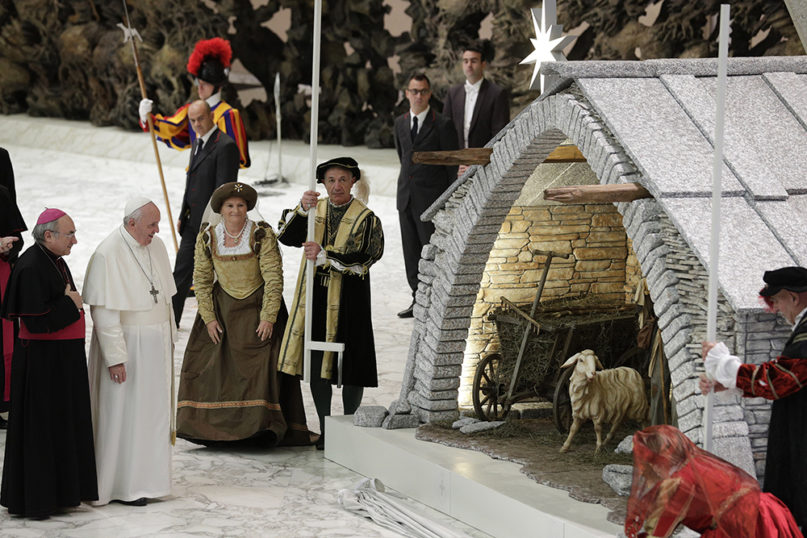
Almost entirely made from wood, the Nativity scene ticks every box of Pope Francis’ pontificate. The plight of immigrants and refugees is depicted by the statue of a man carrying his belongings as he approaches the manger, which is the picture of poverty and humility, while the pope’s environmental message is underlined by the fact that the creche is entirely plastic-free. (The Pope is making the entire Nativity a Political Stunt)
In a private audience with the masons and artisans from Italy’s northern Trento region who created the creche, Pope Francis said the scene “is a genuine way of communicating the gospel, in a world that sometimes seems to be afraid of remembering what Christmas really is and eliminates Christian symbols, only to retain those drawn from a banal, commercial imagination.”
About 25 life-size characters populate this year’s scene, which depicts everyday life in the 19th century, from cheese-making to cleaning and cooking.
At its center, Mary and Joseph surround the empty manger that will host a likeness of baby Jesus on Christmas Day.
The Nativity scene is set under an almost 85-foot-tall spruce that is decorated and lit with the Vatican’s traditionally spare ornaments. During his meeting with those who donated the tree, Francis expressed his appreciation for the fact that 40 new spruces were planted in its place.
People take photos during the Christmas tree and nativity scene lighting ceremony in St. Peter’s Square at the Vatican, Thursday, Dec. 5, 2019. (AP Photo/Gregorio Borgia)
But there is another side to the natural beauty of this year’s Christmas display, as it incorporates fallen trees collected from more than 100,000 acres of land ravaged by a severe storm that hit northern Italy at the end of last year.Bishops attending the ceremony on Thursday said that such events serve as a reminder of the destruction and damage that can occur if humanity does not make a concerted effort to combat climate change. (AND THERE YA GO…Climate Change agenda. IF you are celebrating Christmas as the birth of our Lord, you have no business using the event to promote your political agenda!)
Pope Francis has been a strong advocate for the defense and care of creation, starting with his 2015 encyclical on the environment, “Laudato Si’.” (No, he hasn’t. He has been promoting devotion to “Mother Earth”. Not teaching husbandry of GOD’s creation.)
The first-ever creche was made by the current pope’s namesake, St. Francis, a friar in the Middle Ages who lived his life in poverty after rejecting his inheritance. On Sunday (Dec. 1), the pope made a point of visiting the town of Greccio, not far from Rome, where St. Francis – inspired by its rocky and Bethlehem-like landscape – chose to create the very first creche.
St. Francis enlisted real people in his Nativity pageant in 1223,but the tradition lived on to become the creches we are used to seeing today. (just more idols used by the Catholic Church. They love to worship statues.)
“On December 25, friars came to Greccio from various parts, together with people from the farmsteads in the area, who brought flowers and torches to light up that holy night,” the pope wrote in “Admirabile Signum,” an apostolic letter released during his visit to the historic town.
“I wish to encourage the beautiful family tradition of preparing the nativity scene in the days before Christmas, but also the custom of setting it up in the workplace, in schools, hospitals, prisons and town squares,” the pope wrote. “It is my hope that this custom will never be lost and that, wherever it has fallen into disuse, it can be rediscovered and revived.” (God’s Word FORBIDS us to make graven images.)
According to the pope, the creche “shows God’s tender love” by placing the mystery of the divine within an ordinary setting. (that is another ritual introduced by the Catholic Church. There is no reason to create political art and place it alongside the image of the birth of Christ)More than that, he added, the lowly setting of Christ’s birth “summons us to follow him along the path of humility, poverty and self-denial that leads from the manger of Bethlehem to the cross.”
Francis knows well that among Christian families, setting up a creche is a treasured tradition and one that he doesn’t wish to be forgotten.
“The Christmas crèche is part of the precious yet demanding process of passing on the faith,” he wrote. “Beginning in childhood, and at every stage of our lives, it teaches us to contemplate Jesus, to experience God’s love for us, to feel and believe that God is with us and that we are with him, his children, brothers and sisters all, thanks to that Child who is the Son of God and the Son of the Virgin Mary. And to realize that in that knowledge we find true happiness.” (If that was truly the motivation, they would need nothing but Jesus, Mary and Joseph… No elaborate staging, fancy sculpting, or political theme.)
spacer
spacer
2020 Donated by Abruzzo
This ceramic nativity is just a small part of 54 piece set from the 1960s and 1970s. We have a spark plug angel – or is it iron maiden torture device angel, an astronaut, and a very modern set.Behind the astronaut is an evil looking figure, maybe a knight? Seeing a horned figure, who will soon stand over Baby Jesus, at the Vatican no less, brings me no joy.Speaking of Baby Jesus, He has His head covered/blindfolded until Christmas – it looks like a kidnapping. But at least the tree is gorgeous.

spacer
Don’t be fooled for one minute. These Vatican Nativity Displays are all part of the Magick Workings of the Freemasons/Illuminati/Magi/Royals/Elite. All of the symbolism is carefully selected and meticulously placed. This theme fits perfectly with the Alien Agenda/Space Magic going on today. They want everyone focused on the SPACE PROGRAM and UFO’s. They want to get people believing that traveling to space in space ships is our salvation. And/or that ALIEN’s are coming back to reclaim us. LIES! LIES! LIES!
Mini Pope Francis featured in Vatican’s annual 100 nativity scenes display
.- Among the novelties of this year’s “100 Nativity Scenes at the Vatican” exhibit is the inclusion of a miniature Pope Francis honoring the Christ Child. (honoring the Christ Child? Doesn’t look like that to me.)
The small statue of the pontiff is part of a piece that recreates the scene of March 27, 2020, when Pope Francis stood in a rainy and empty St. Peter’s Square to pray for an end to the coronavirus pandemic.
In addition to Pope Francis and the Child Jesus in a manger, the model depicts the front of St. Peter’s Basilica and the miraculous crucifixof the Church of San Marcello al Corso.
(Do you see Infant Jesus is on the floor which looks like snakeskin, at the Pope’s feet. The Pope is towering over him, the most lit figure present. In the background is Jesus, still on the cross, crucified again and again, according to the Catholic teaching. Who is the focus here? Who is the power represented here? )
The annual nativity scene display began in 1976.Before 2018, the nativities were exhibited in Rome’s Piazza del Popolo. This is the third year that the display is under the leadership of the Vatican.
But this year, for safety reasons, the nativities were moved from a building near the Vatican to the open air, under a part of Bernini’s famous colonnade, which embraces St. Peter’s Square. Wooden displays hold the nativities and protect them from the elements.
Space limitations mean the exhibit is slightly smaller this year. Archbishop Rino Fisichella, who leads the Pontifical Council for the Promotion of the New Evangelization, told CNA that there were around 70nativities set up for viewing.
Some of the nativity scenes come from other countries. In addition to traditional Italian manger scenes, there are those that have been handmade with more unusual materials, such as paper, straw, stones, and even type from a typewriter.
Most of the scenes included have been displayed also in previous years, but there are a few new ones for 2020. For example, Vatican firemen put together a nativity scene that sits inside an old fire extinguisher.
Some of the nativities were made by schoolchildren.
The display also includes poinsettia plants and large signs with quotations from Pope Francis about the significance of the nativity.
The new location of the exhibit, under the colonnade, is where some homeless people spend the day. At night, many more sleep around the outside edge of the colonnade in sleeping bags or tents if they have them –– or on top of cardboard to protect them from the cold stone.
“Everyone will be able to stop and admire the beauty of many nativity scenes from different parts of the world and understand how much love and imagination have been put into the creation of the manger scene,” a press release from the Pontifical Council for the Promotion of the New Evangelization said.
“If we are experiencing a feeling of sadness or loneliness, let us approach the crib and look at the Baby Jesus who wants to be welcomed. Then we too stretch out our arms, hold him and we will feel less alone,” Fisichella told Vatican News.
The New Evangelization office, which organizes the exhibit each year, said that “Christmas is the light that comes into the world to dispel the darkness of evil.” (CHRISTMAS IS THE LIGHT??? WHAT?? CHRISTMAS ISN’T EVEN CHRISTIAN!! JESUS IS THE LIGHT OF THE WORLD! He is the HOPE of the WORLD! He is the ONE who defeats the enemy.)
“These Christmas holidays, it would make no sense to look away as if the dramatic moment that the whole world is experiencing did not exist. Faith requires us to look at reality and give meaning to what happens in personal history and in humanity,” it said. (What? We can’t give meaning to anything. We can only seek out the will of GOD. We can turn to him for guidance, protection and provision. He is AUTHOR and the FINISHER of OUR FAITH!)
The display was opened to visitors Dec. 13 (12/13) and will close after Jan. 10. (1/10)
Photographs of nativity scenes by Hannah Brockhaus/
spacer
Even the Pope Seems Iffy on the Vatican’s Astronaut-Themed Nativity. Here’s How the Artwork Became a Lighting Rod
The ceramic crèche was made by art students and teachers in the city of Castelli in 1965, but it’s too avant-garde for some.
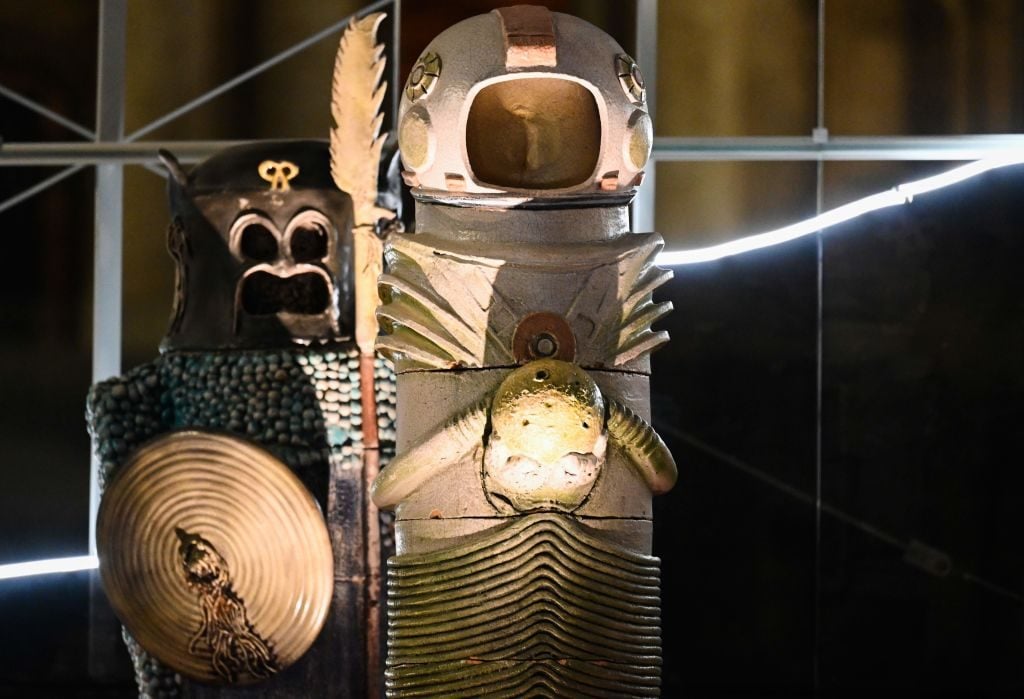
This year has brought so many strange art-related developments, from mysterious desertmonoliths to Cookie Monster murals. And if the final square of your “Memes of 2020” bingo card was “time-traveling astronaut visiting Baby Jesus,” you are in luck. Believe it or not, this marvel comes courtesy the Vatican.
In case you missed this latest bit of news, here is everything you need to know.
Wait, what in the world are you talking about?
Two weeks before Christmas, the Vatican brought forth its annual display of its nativity scene. The tradition goes back to Pope St. John Paul II, who kicked it off in 1982.
Catholics wait with bated breath for the unveiling of each year’s sculptural set, usually donated by an Italian town. This year, the Vatican also unveiled its annual Christmas tree, a 91-foot-tall spruce from Slovenia.
“The Vatican wants the Nativity scene and Christmas tree this year to be a sign of hope against COVID-19,” Rome Reports relayed at the end of October. But since its December 11 unveiling, its message of comfort has been somewhat drowned out by a wave of reaction to the display’s unconventional nature.
So, what does this year’s look like?
Well, it’s not the usual.
The figures’ bodies are defined by simple cylinders, topped by spheres for the heads, with no limbs.There’s no traditional setting, no wooden manger, no straw on the ground, just a very minimalist empty space.
“It made me think of bowling pins with Baby Jesus as a ball,” one visitor told Reuters of the design.
Perhaps alluding to a landscape, a glowing light behind the figures makes it seem as though they’re being struck by lightning.
What attracts the most attention, however, is the figure who appears to be an astronaut,in a spacesuit, gripping the moon in his hands. There’s also a sinister-looking figure in a black helmet who many have compared—perhaps on account of the space theme—to Darth Vader from Star Wars.
So, where did this display come from?
The sculptures on view are part of a larger, 52-piece set created by students and teachers of the F.A. Grue Art Institute, in the town of Castelli. Started in 1965, it took a decade to complete.
Figures from the Vatican crèche, a monumental nativity scene made up of larger-than-life ceramic statues made in the village of Castelli in the Abruzzo region of Italy, at St. Peters Square in the Vatican. (Photo by Vincenzo Pinto/AFP via Getty Images.)
Known for its ceramics tradition, Castelli lies in Italy’s Abruzzi region. In fact, the five colors known as the “Castelli Palette” predominate in the ceramic nativity.
The St. Peter’s Diocese website helpfully points out art historical precedents for the figures’ strangely proportioned features, including Mesopotamian sculpture. It also mentions precedents as diverse as Renaissance art, the neo-baroque, and the work of self-taught artists.
While the ceramic figures have created a sensation in this year’s Vatican display, this is not the first time they have been seen publicly.The sculptures have even been on tour, going on view in Rome on Christmas in 1970 and later doing several gigs in the Middle East, in Jerusalem, Tel Aviv, and even Bethlehem, Jesus’s birthplace.
Why in the world is there an astronaut there?
Four years into the Castelli school’s work on the sculpture set, astronauts first walked on the moon, in 1969. In honor of that accomplishment, the sculptors put in their Italian Neil Armstrong.
Many have pointed out that previous Vatican displays have also included seemingly incongruous elements.
For instance, in 2016, a Maltese fishing boat appeared in the display in reference to the plight of refugees(just as America’s wall-building president was about to take office).
2017’s realist display from the town of Montevergine featured figures performing acts of mercy, like feeding the destitute, visiting the incarcerated, and clothing the naked. That display, too, generated controversy, when the depiction of “clothing the naked” was considered to be so sexy as to be potential gay propaganda, with Catholic Family News blasting it as “obscene.”
What do critics have to say about the Space Nativity?
The National Catholic Register complains of a “satanic-looking executioner—but no manger.” (Artist Fausto Cheg, a member of the team that created the sculpture, has said that the executioner figure, in fact, refers to the abolition of the death penalty.) (Ya, whatever!)
Catholic Herald contributing editor Tim Stanley calls it “absolutely terrifying.”
A writer for the Catholic Heraldcalls the nativity “embarrassing,”but opines that perhaps its break with tradition can reach new audiences: “When the Church encounters a new culture of, say, an indigenous tribe, or a society quite foreign to European aesthetics and sensibilities,” he writes, “She will experiment with blending some of their native expressions with the Church’s patrimony as part of the work of evangelization. It is therefore fair that She also do this with modern Western culture.” (So this is their “new EVANGELISM”?)
And who’s to say that’s wrong? Writer Matt Stansberry took to Twitter to quip that the nativity “by far the church’s best effort to bring me back into the fold.” (I AM HERE TO SAY IT IS WRONG! AND I AM NOT ALONE!)
Has Pope Francis weighed in?
Yes and no.
In general, he is pro-anachronism. “It is customary to add many symbolic figures to our nativity scenes,” Pope Francis said in 2019. “Children—but adults too!—often love to add to the nativity scene other figures that have no apparent connection with the Gospel accounts. Yet, each in its own way, these fanciful additions show that in the new world inaugurated by Jesus there is room for whatever is truly human and for all God’s creatures.” (Jesus did not inaugurate this NEW WORLD. And we are not children. It is ridiculous that this New World wants to force children to deal with adult issues they cannot handle, and wants adults to be children.)
Nativity scene of the Vatican Firefighters during the inauguration of the exhibition “100 Nativity Scenes” under Bernini’s colonnade in St. Peter’s Square, December 13th, 2020. (Photo by Grzegorz Galazka/Archivio Grzegorz Galazka/Mondadori Portfolio via Getty Images.)
On Sunday, however, the Pope pointedly did not recommend seeing the unconventional Nativity during an address. Speaking to visitors from his window overlooking Vatican Square, Francis instead twice exhorted them to visit a nearby exhibition of more than 100 nativity displays, which he said showed “how people try to use art to show how Jesus was born.” (Well the Vatican cannot claim that they were caught off guard or surprised by this display, it has been well known since 1970. So cut the crap!)
No mention was made of poor Italian Neil Armstrong. Given the ongoing mocking of the Castelli ceramics display, the silence from the Pope has been widely interpreted as a deliberate snub. BS!
Has anyone else taken to Twitter to weigh in?
Surprisingly, yes!
tweet
Tweet
Tweet
Tweet
Tweet
@ericaisabellesIt looks like Tim Burton did the Vatican’s nativity scene this year
Tweet
Yes!
spacer
2021: A gift from Peru, the Nativity scene in St. Peter’s Square featured llamas and superfood for Baby Jesus, representing the Chopcca Nation’s traditional manger scene from the Huancavelica region.
It’s the first time the Vatican’s Nativity scene comes from the Americas.
2022: Focused on sustainability, the 2022 Nativity Scene displayed hand-carved figures without cutting down trees. The 30-meter white fir tree, sourced from Rosello, Abruzzi, stood tall in St. Peter’s Square, symbolizing solidarity and was showcased inside due to inclement weather.
spacer
Not one tree was cut down to create the hand-carved figures

Center of 2022 crèche in St. Peter’s Square
On December 3 at 5 PM, Cardinal Fernando Vérgez Alzaga, President of the Governorate of the Vatican City State, unveiled the 2022 Nativity Scene and presided over the lighting of the Christmas Tree in St. Peter’s Square. Due to torrential rain and thunderstorms the ceremony was held inside the Paul VI’s Audience Hall. The tree and crèche will remain on display until Sunday, January 8, 2023, traditionally the anniversary of Jesus’s Baptism.
The majestic 30-meter white fir tree comes from the tiny mountain village of Rosello, home to some 180 inhabitants, in the Abruzzi, very near the border with Molise, located at nearly 1000 meters above sea level on the slope of a cliff overlooking the entire Valley of the River Sangro. According to tradition, Rosello owes its medieval origin to the Benedictine monks of the Abbey of San Giovanni in Verde.

Solidarity with the marangon or carpenter in the background
It’s also home to the best-preserved nucleus of white fir trees in Italy, including the tallest spontaneous one, almost 55 meters in height. Young people who reside at the “Quadrifoglio”, a psychiatric rehabilitation facility in Rosello, made the tree’s decorations.
This year’s crèche is entirely made of hand-carved wood. It’s a temporary gift from another charming small town: Sutrio, in the Carnia region of Friuli Venezia Giulia, situated in the northwest of the province of Udine and nestled in the foothills of Mount Zoncolan, famous to cyclists worldwide.
With a long tradition of woodworking and crèche carving because of its ubiquitous surrounding forests, on display here yearlong is its mechanical wooden crèche “Teno” of local scenes and traditions, which took Sutrio’s great artisan Gaudenzio Straulino thirty years to build. Moreover, every September this magical town of small stone houses along cobbled streets, hosts the exhibition of wood-related craftsmanship called the “Magic of Wood”. Not to mention that Sutrio is the starting point of the giro presepi in Friuli Venezia Giulia to Poffabro almost 80 kilometers away. Its route passes through the Riserva Naturale Regionale del Lago di Cornino. Traditionally on December 24, after Midnight Mass on the shore of the lake, scuba divers lower a statue of Jesus into its waters.
The theme of Sutrio’s 2022 Vatican crèche is sustainability of natural resources, the importance of family, and solidarity towards others. Subsidized by the Region Friuli Venezia Giulia, the Archdiocese of Udine, and Promo Turismo FVG, the crèche counts 18 life-size sculptures: the traditional Holy Family; the Three Kings; a bull; small donkey; sheep; and, accompanied by a second sheep, a shepherdess seated beside her gerla or backpack made of woven reeds, still a typical accessory of mountain people.

The other eight sculptures include two children, a girl seated on the steps leading up to the Holy Family, and a boy peering into the “grotto”; a family of three embracing; two men, one helping the other, representing “solidarity”; a lady weaving at her loom, still today a typical female occupation in Carnia; a cramar or peddler, who used to travel on foot in Carnia from town to town carrying a wooden chest of drawers on his back filled with handmade wares and spices for sale; a marangon or carpenter intent on planing a wooden board on his work bench, and the dome’s angel.
The Baby Jesus, carefully covered until Midnight on Christmas morning, is made of linden wood and his manger sculpted from the roots of one of the 10 million trees blown over in the terrible windstorm “Vaia” between October 26 and November 5, 2018. Otherwise, all the statues are carved out of cedar wood from Friuli Venezia Giulia harvested by professional local foresters. Not one tree was purposefully chopped down to make any part of this Nativity scene.
The crèche’s eleven sculptors are all residents of Friuli Venezia Giulia: project manager Stefano Comelli carved one of the Three Kings and “Solidarity”; Capuchin priest Gianni Bordin the Madonna and the little boy; Andrea Caisutti the bull, donkey, and weaver; Corrado Clerici St. Joseph and the marangon; Paolo Figar the two other Three Kings; Arianna Gasperina the little girl and the shepherdess; Isaia Moro the cramar;

Melchior, one of the Three Kings
Martha Alberta Muser the manger; Ukrainian-born engineer “Sasha” Oleksander Shtieyninher residing in Italy since 1999, the dome and angel; Herman Plozzer the family of three and the sheep; and Renato Puntel Baby Jesus; all worked two years to complete their figures. Each artist was given total artistic freedom for his or her inspiration, just as each beholder of the crèche will interpret the scene individually.
 The 18 sculptures are distributed over a surface of 116 square meters and under a 5.65-meter high dome made of larch with an overhanging angel. Fifty spotlights, shining down from the angel, illuminate the scene. After January 8th the crèche will be permanently displayed in Sutrio’s main piazza.cer
The 18 sculptures are distributed over a surface of 116 square meters and under a 5.65-meter high dome made of larch with an overhanging angel. Fifty spotlights, shining down from the angel, illuminate the scene. After January 8th the crèche will be permanently displayed in Sutrio’s main piazza.cer
spacer
Croatian design team illuminates Vatican Nativity Scene in Saint Peter’s Square
by croatiaweek
December 26, 2022
26 December 2022 – Croatian company Skira from Pula, which specialises in lighting design, had the honour of lighting this year’s Christmas nativity scene that is decorating St. Peter’s Square at the Vatican until 8 January 2023.
The collaboration on the staging of the birth of Jesus started from the recommendation of Italian colleagues who recognised that for the lighting of the staging of the birth of Jesus it is necessary to have competence in creative solutions and experience with technologically demanding projects in order to highlight the beauty and warmth of natural materials with light.
Skira have worked on a number of award-winning lighting projects in Croatia and abroad, including for the London underground tunnels, Eurasia tunnel, the GTC Matrix twin office buildings in Zagreb and the Pula shipyards.
 |
 |
spacer
2023: The Vatican’s Nativity scene honored St. Francis of Assisi’s 800th anniversary. Life-sized terracotta figures, alongside a 25-meter Christmas tree adorned with edelweiss, symbolized hope in St. Peter’s Square until January 7, 2024.
The Vatican’s 2023 Nativity scene in St. Peter’s Square honors St. Francis of Assisi’s 800th anniversary. Crafted by sculptor Antonio Cantone, it features life-sized terracotta figures of Mary, Joseph, and St. Francis. The scene mirrors Greccio’s historical setting, complemented by a replica fresco from the Chapel of the Nativity.
The 91 ft. Christmas tree, adorned with nursery-grown edelweiss, accompanies this sacred display. Both symbolize hope and grace throughout the Christmas season until January 7, 2024. Crafted from sustainable cedar wood, the crib, resembling a Grotto, houses the Holy Family, surrounded by artisans, paying homage to traditional craftsmen from Greccio.
spacer
ON ONE SIDE OF THE MANGER, MARY KNEELS, FLANKED BY JOSEPH, WHILE ON THE OTHER SIDE, ST. FRANCIS OF ASSISI STANDS IN A POSE OF WONDER.
The scene was unveiled Saturday.
From CNA:
The scene in St. Peter’s Square depicts not only Mary and Joseph standing beside the manger but also St. Francis of Assisi, who organized the first Nativity scene in a cave in the Italian village of Greccio on Christmas Eve in 1223.
Cardinal Fernando Vérgez Alzaga, the president of the Governorate of Vatican City State, presided over the Dec. 9 inauguration ceremony. Over a thousand people gathered in the square for the event, which included moments of catechesis, an explanation of how the scene was put together, and the singing of seasonal hymns.
The Vatican’s Greccio-inspired Nativity scene does not include live animals and people as St. Francis’ original did, but it does feature life-sized terracotta figures, crafted by renowned Neapolitan sculptor Antonio Cantone.
At the center of the scene is the now-empty manger, where a figure of the newborn savior will be placed on Christmas Eve. On one side of the manger, Mary kneels, flanked by Joseph, while on the other side, St. Francis of Assisi stands in a pose of wonder.
n addition to Mary, Joseph, St. Francis, and the traditional ox and donkey, the 13th-century mayor of Greccio who helped organize the first Nativity scene, Giovanni Velita, is featured in statue form, along with his wife, Alticama.
Pope Francis welcomed the donors of the Nativity scene on Saturday and offered these remarks:
The Nativity display set up in Saint Peter’s Square aims to evoke, after eight hundred years, the Christmas atmosphere of the year 1223 in the Rieti Valley, where Saint Francis stopped. His journey to the Holy Land was still vivid in his mind and the caves of Greccio reminded him of the landscape of Bethlehem. Therefore, he asked to depict the Christmas scene in that small village: many friars arrived from various parts and men and women also came from the cottages in the area, creating a living nativity scene. Thus, the tradition of the nativity scene as we understand it was born.
spacer
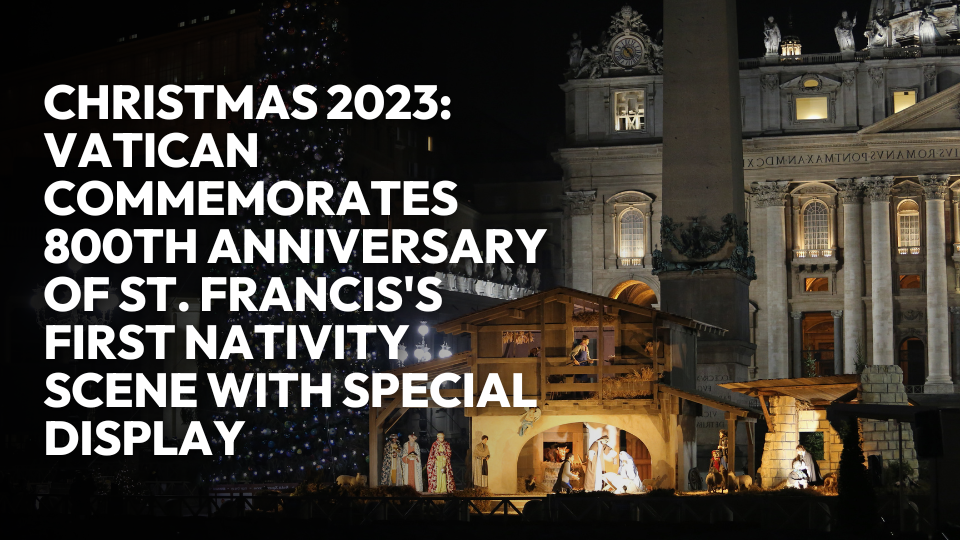
2023-10-30
Marking a dual anniversary of 800 years since St. Francis of Assisi created the first nativity scene in Greccio and Pope Honorius III approved the “Regola Bollata” for the Friars Minor, this year’s Nativity display in St. Peter’s Square draws inspiration from the Valley of Reatina, in the Diocese of Rieti. Additionally, the monumental Christmas tree gracing the Square originates from the high Maira Valley in the town of Macra, located in the Diocese of Saluzzo and the province of Cuneo.
The nativity display in St. Peter’s Square seeks to evoke the atmosphere of Christmas 1223, the year St. Francis, having returned from a journey to the Holy Land, wished to commemorate the birth of Jesus in Greccio, a village reminiscent of Bethlehem. Expert artisans, guided by the designs of Francesco Artese, have crafted life-sized terracotta figures dressed in 13th-century attire, paying homage to the world’s first living nativity scene as described by Thomas of Celano.
This year’s display also pays tribute to the four Franciscan shrines and the city of Rieti. The scene presents an artistic representation of the first Nativity, featuring a friar celebrating mass before an image of the grotto of Greccio, with St. Francis holding the baby Jesus beside the Virgin Mary and a kneeling St. Joseph. This entire setup is set on an octagonal base, commemorating the 800th anniversary of the event.
In the Paul VI Hall, thousands of Venetian glass tiles will depict the Nativity. Welcoming the Christ child are St. Francis and St. Clare, embodying the essence of the Franciscan universe. The masterpiece, created by mosaic artist Alessandro Serena from Spilimbergo (Pordenone), will find a permanent home in Rieti after its Vatican display.
The white fir tree, soaring nearly 25 meters high, hails from Macra’s lush green alpine valley. Residents of Albaretto in Macra, proud of their mountain heritage and committed to renewal, initiated the generous donation of the tree to Pope Francis. The gesture underscored their solidarity with the Pontiff and was made possible with support from the town of Cuneo.
A unique feature this year is the tree’s decoration, emphasizing care for our common home, reflecting the spirit of Pope Francis’ encyclical, “Laudato si’.” Thousands of edelweiss flowers, symbolizing snow and the unique character of the Maira Valley, will adorn the tree. Notably, these alpine flowers typically found above 1800 meters in elevation, are cultivated in the plains by Edelweiss of Villar San Costanzo, ensuring their preservation in their natural habitat.
The tree and nativity scenes will remain on display until the end of the Christmas season, culminating on the feast of the Baptism of the Lord on January 7, 2024.
spacer





 Tweet
Tweet

